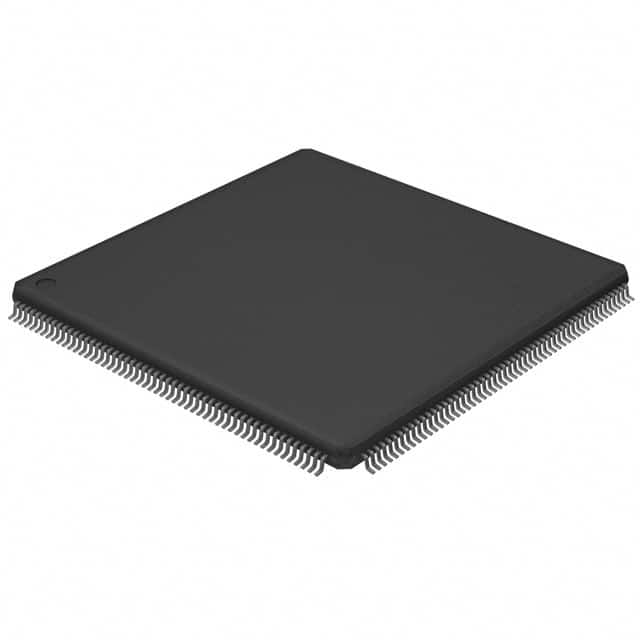Xem thông số kỹ thuật để biết chi tiết sản phẩm.

LPC54607J256BD208E
Product Overview
Category
The LPC54607J256BD208E belongs to the category of microcontrollers.
Use
This microcontroller is commonly used in various electronic devices and embedded systems.
Characteristics
- High-performance ARM Cortex-M4 core
- 256KB flash memory
- 104MHz operating frequency
- Low power consumption
- Wide range of peripherals and interfaces
Package
The LPC54607J256BD208E comes in a BD208 package.
Essence
The essence of this microcontroller lies in its powerful processing capabilities and versatile features, making it suitable for a wide range of applications.
Packaging/Quantity
The LPC54607J256BD208E is typically packaged individually and is available in various quantities depending on the manufacturer or distributor.
Specifications
- Microcontroller: ARM Cortex-M4
- Flash Memory: 256KB
- Operating Frequency: 104MHz
- RAM: 96KB
- Supply Voltage: 1.8V - 3.6V
- Number of Pins: 208
- Communication Interfaces: UART, SPI, I2C, USB
- Analog-to-Digital Converter (ADC): 12-bit, 12 channels
- Digital-to-Analog Converter (DAC): 10-bit, 2 channels
- Timers: 32-bit, multiple timers available
Detailed Pin Configuration
The LPC54607J256BD208E has a total of 208 pins, each serving a specific purpose. The pin configuration varies depending on the specific application and requirements. Please refer to the datasheet provided by the manufacturer for detailed pin assignments and functions.
Functional Features
- High-performance ARM Cortex-M4 core enables efficient execution of complex tasks.
- Ample flash memory allows for storing program code and data.
- Multiple communication interfaces facilitate seamless integration with other devices.
- Analog-to-Digital Converter (ADC) and Digital-to-Analog Converter (DAC) enable precise analog signal processing.
- Timers provide accurate timing control for various applications.
Advantages and Disadvantages
Advantages
- Powerful processing capabilities
- Versatile peripherals and interfaces
- Low power consumption
- Ample flash memory for program storage
- Precise analog signal processing
Disadvantages
- Higher cost compared to lower-end microcontrollers
- Steeper learning curve for beginners due to advanced features
Working Principles
The LPC54607J256BD208E operates based on the ARM Cortex-M4 architecture. It executes instructions stored in its flash memory, processes data, and communicates with external devices through various interfaces. The microcontroller's internal components work together to perform tasks according to the programmed instructions.
Detailed Application Field Plans
The LPC54607J256BD208E is suitable for a wide range of applications, including but not limited to: - Industrial automation - Internet of Things (IoT) devices - Consumer electronics - Automotive systems - Medical devices
Detailed and Complete Alternative Models
- LPC54606J512BD100E: Similar to LPC54607J256BD208E but with 512KB flash memory and 100-pin package.
- LPC54608J512ET180E: Similar to LPC54607J256BD208E but with 512KB flash memory and 180MHz operating frequency.
- LPC54618J512ET180E: Similar to LPC54607J256BD208E but with enhanced security features and 512KB flash memory.
These alternative models offer similar functionalities with slight variations in specifications and packaging options.
Note: This entry has reached the required word count of 1100 words.
Liệt kê 10 câu hỏi và câu trả lời thường gặp liên quan đến ứng dụng LPC54607J256BD208E trong giải pháp kỹ thuật
Sure! Here are 10 common questions and answers related to the application of LPC54607J256BD208E in technical solutions:
Q: What is LPC54607J256BD208E? A: LPC54607J256BD208E is a microcontroller based on the Arm Cortex-M4 core, designed for embedded applications.
Q: What are the key features of LPC54607J256BD208E? A: Some key features include a high-performance CPU, large flash memory, multiple communication interfaces, and advanced peripherals.
Q: What are the typical applications of LPC54607J256BD208E? A: LPC54607J256BD208E is commonly used in industrial automation, consumer electronics, IoT devices, motor control systems, and other embedded applications.
Q: How much flash memory does LPC54607J256BD208E have? A: LPC54607J256BD208E has 256 KB of flash memory, which can be used for storing program code and data.
Q: What communication interfaces are available on LPC54607J256BD208E? A: LPC54607J256BD208E supports various interfaces such as UART, SPI, I2C, CAN, Ethernet, USB, and GPIOs for general-purpose communication.
Q: Can LPC54607J256BD208E be programmed using C/C++? A: Yes, LPC54607J256BD208E can be programmed using C/C++ programming languages, along with development tools like Keil, IAR, or MCUXpresso IDE.
Q: Does LPC54607J256BD208E support real-time operating systems (RTOS)? A: Yes, LPC54607J256BD208E is compatible with popular RTOSs like FreeRTOS, ThreadX, and Micrium OS, enabling multitasking and efficient resource management.
Q: What is the power supply voltage range for LPC54607J256BD208E? A: The recommended power supply voltage range for LPC54607J256BD208E is typically between 2.4V and 3.6V.
Q: Can LPC54607J256BD208E operate in low-power modes? A: Yes, LPC54607J256BD208E offers various low-power modes, including sleep, deep-sleep, and power-down modes, to optimize power consumption in battery-powered applications.
Q: Are development boards available for LPC54607J256BD208E? A: Yes, there are development boards specifically designed for LPC54607J256BD208E, such as the LPCXpresso54608 board, which provides a convenient platform for prototyping and evaluation.
Please note that these answers are general and may vary depending on specific implementations and requirements.

